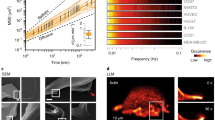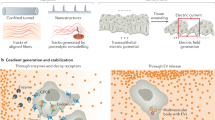Abstract
Current models of eukaryotic chemotaxis propose that directional sensing causes localized generation of new pseudopods1. However, quantitative analysis of pseudopod generation suggests a fundamentally different mechanism for chemotaxis in shallow gradients: first, pseudopods in multiple cell types are usually generated when existing ones bifurcate and are rarely made de novo; second, in Dictyostelium cells in shallow chemoattractant gradients, pseudopods are made at the same rate whether cells are moving up or down gradients. The location and direction of new pseudopods are random within the range allowed by bifurcation and are not oriented by chemoattractants. Thus, pseudopod generation is controlled independently of chemotactic signalling. Third, directional sensing is mediated by maintaining the most accurate existing pseudopod, rather than through the generation of new ones. Finally, the phosphatidylinositol 3-kinase (PI(3)K) inhibitor LY294002 affects the frequency of pseudopod generation, but not the accuracy of selection, suggesting that PI(3)K regulates the underlying mechanism of cell movement, rather than control of direction.
This is a preview of subscription content, access via your institution
Access options
Subscribe to this journal
Receive 12 print issues and online access
$209.00 per year
only $17.42 per issue
Buy this article
- Purchase on Springer Link
- Instant access to full article PDF
Prices may be subject to local taxes which are calculated during checkout





Similar content being viewed by others
References
Firtel, R. A. & Chung, C. Y. The molecular genetics of chemotaxis: sensing and responding to chemoattractant gradients. Bioessays 22, 603–615 (2000).
Devreotes, P. N. & Zigmond, S. H. Chemotaxis in eukaryotic cells: a focus on leukocytes and Dictyostelium. Annu. Rev. Cell Biol. 4, 649–686 (1988).
Zigmond, S. H. Ability of polymorphonuclear leukocytes to orient in gradients of chemotactic factors. J. Cell Biol. 75, 606–616 (1977).
Parent, C. A., Blacklock, B. J., Froehlich, W. M., Murphy, D. B. & Devreotes, P. N. G-protein signaling events are activated at the leading edge of chemotactic cells. Cell 95, 81–91 (1998).
Devreotes, P. & Janetopoulos, C. Eukaryotic chemotaxis: distinctions between directional sensing and polarization. J. Biol. Chem. 278, 20445–20448 (2003).
Sun, C. X. et al. Rac1 is the small GTPase responsible for regulating the neutrophil chemotaxis compass. Blood 104, 3758–3765 (2004).
Weiner, O. D. Regulation of cell polarity during eukaryotic chemotaxis: the chemotactic compass. Curr. Opin. Cell Biol. 14, 196–202 (2002).
Gerisch, G. & Keller, H. U. Chemotactic reorientation of granulocytes stimulated with micropipettes containing fMet-Leu-Phe. J. Cell Sci. 52, 1–10 (1981).
Wessels, D., Murray, J., Jung, G., Hammer, J. A. & Soll, D. R. Myosin IB null mutants of Dictyostelium exhibit abnormalities in motility. Cell Motil. Cytoskeleton 20, 301–315 (1991).
Wessels, D. et al. RasC plays a role in transduction of temporal gradient information in the cyclic-AMP wave of Dictyostelium discoideum. Eukaryot. Cell 3, 646–662 (2004).
Chen, L. et al. Two phases of actin polymerization display different dependencies on PI(3,4,5)P3 accumulation and have unique roles during chemotaxis. Mol. Biol. Cell 14, 5028–5037 (2003).
Ma, L., Janetopoulos, C., Yang, L., Devreotes, P. N. & Iglesias, P. A. Two complementary, local excitation, global inhibition mechanisms acting in parallel can explain the chemoattractant-induced regulation of PI(3,4,5)P3 response in Dictyostelium cells. Biophys. J. 87, 3764–3774 (2004).
Brahmbhatt, A. A. & Klemke, R. L. ERK and RhoA differentially regulate pseudopodia growth and retraction during chemotaxis. J. Biol. Chem. 278, 13016–13025 (2003).
Shutt, D. C. et al. Ponticulin plays a role in the positional stabilization of pseudopods. J. Cell Biol. 131, 1495–1506 (1995).
Stepanovic, V., Wessels, D., Daniels, K., Loomis, W. F. & Soll, D. R. Intracellular role of adenylyl cyclase in regulation of lateral pseudopod formation during Dictyostelium chemotaxis. Eukaryot. Cell 4, 775–786 (2005).
Wang, Y. & O'Halloran, T. J. Abp1 regulates pseudopodium number in chemotaxing Dictyostelium cells. J. Cell Sci. 119, 702–710 (2006).
Wessels, D., Titus, M. & Soll, D. R. A Dictyostelium myosin I plays a crucial role in regulating the frequency of pseudopods formed on the substratum. Cell Motil. Cytoskeleton 33, 64–79 (1996).
Carlier, M. F., Wiesner, S., Le Clainche, C. & Pantaloni, D. Actin-based motility as a self-organized system: mechanism and reconstitution in vitro. C. R. Biol 326, 161–170 (2003).
Arrieumerlou, C. & Meyer, T. A local coupling model and compass parameter for eukaryotic chemotaxis. Dev. Cell 8, 215–227 (2005).
Tranquillo, R. T., Lauffenburger, D. A. & Zigmond, S. H. A stochastic model for leukocyte random motility and chemotaxis based on receptor binding fluctuations. J. Cell Biol. 106, 303–309 (1988).
Bourne, H. R. & Weiner, O. A chemical compass. Nature 419, 21 (2002).
Zigmond, S. H., Levitsky, H. I. & Kreel, B. J. Cell polarity: an examination of its behavioral expression and its consequences for polymorphonuclear leukocyte chemotaxis. J. Cell Biol. 89, 585–592 (1981).
Swanson, J. A. & Taylor, D. L. Local and spatially coordinated movements in Dictyostelium discoideum amoebae during chemotaxis. Cell 28, 225–232 (1982).
Blagg, S. L., Stewart, M., Sambles, C. & Insall, R. H. PIR121 regulates pseudopod dynamics and SCAR activity in Dictyostelium. Curr. Biol. 13, 1480–1487 (2003).
Postma, M. et al. Uniform cAMP stimulation of Dictyostelium cells induces localized patches of signal transduction and pseudopodia. Mol. Biol. Cell 14, 5019–5027 (2003).
Postma, M. et al. Sensitization of Dictyostelium chemotaxis by phosphoinositide-3-kinase-mediated self-organizing signalling patches. J. Cell Sci. 117, 2925–2935 (2004).
Meinhardt, H. Orientation of chemotactic cells and growth cones: models and mechanisms. J. Cell Sci. 112, 2867–2874 (1999).
Postma, M. & Van Haastert, P. J. A diffusion-translocation model for gradient sensing by chemotactic cells. Biophys. J. 81, 1314–1323 (2001).
Sheikh, S. & Nash, G. B. Continuous activation and deactivation of integrin CD11b/CD18 during de novo expression enables rolling neutrophils to immobilize on platelets. Blood 87, 5040–5050 (1996).
Laevsky, G. & Knecht, D. A. Under-agarose folate chemotaxis of Dictyostelium discoideum amoebae in permissive and mechanically inhibited conditions. Biotechniques 31, 1140–1149 (2001).
Acknowledgements
Thanks to S. Dimmock and T. Luu for help with isolating human neutrophils. Thanks to J. A. Legg for preparing fibroblast cultures.
Author information
Authors and Affiliations
Contributions
N.A. performed all published experiments and numerial analysis. R.I. performed prelininary experiments. N.A. and R.I. planned the work and wrote the paper together.
Corresponding author
Ethics declarations
Competing interests
The authors declare no competing financial interests.
Supplementary information
Supplementary Information
Supplementary Figures S1, S2, S3 and S4 (PDF 1571 kb)
Supplementary Information
Supplementary Movie S1 (MOV 1167 kb)
Supplementary Information
Supplementary Movie S2 (MOV 840 kb)
Supplementary Information
Supplementary Movie S3 (MOV 729 kb)
Rights and permissions
About this article
Cite this article
Andrew, N., Insall, R. Chemotaxis in shallow gradients is mediated independently of PtdIns 3-kinase by biased choices between random protrusions. Nat Cell Biol 9, 193–200 (2007). https://doi.org/10.1038/ncb1536
Received:
Accepted:
Published:
Issue Date:
DOI: https://doi.org/10.1038/ncb1536
This article is cited by
-
Electric signals counterbalanced posterior vs anterior PTEN signaling in directed migration of Dictyostelium
Cell & Bioscience (2021)
-
The principles of directed cell migration
Nature Reviews Molecular Cell Biology (2021)
-
WAVE complex regulation by force
Nature Cell Biology (2021)
-
Multi-omics analysis identifies FoxO1 as a regulator of macrophage function through metabolic reprogramming
Cell Death & Disease (2020)
-
The creatine–phosphagen system is mechanoresponsive in pancreatic adenocarcinoma and fuels invasion and metastasis
Nature Metabolism (2020)



